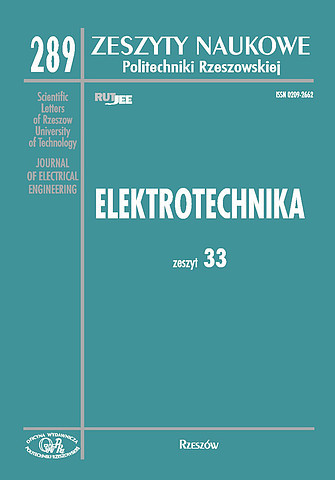Abstract
The article describes the design of electronic control system of three-phase induction motor. The control system is based on the 32-bit microcontroller STM32F103 Cortex-M3 core. On the basis of the designed control system laboratory testing was performed. It shows the impact of changes of the frequency of the output waveform control system for the engine operation as a results of laboratory tests. The scalar method of the induction motor control was adopted as a main control system. This method has the task of maintaining the stability of the value of the quotient voltage and frequency. This characterization has been modified by the introduction of adjustments taking into account differences in component inheritance voltage rheostat resulting from the varying frequency of supply. It has been covered by the two-level control feedback in order to control of engine parameters. The main level controls the rotational speed, the slave level controls a current value. The process of adjusting induction motor requires knowledge of current values and current speed. The value of the measured current was physically as a direct current circuit. Based on this value the value of the phase currents were calculated. This required knowledge of the status of the inverter. The speed given on the adjustment system was approximated by applying an internal feedback loop. This solution allows you to use system developed primarily in the propulsion power tools or kitchen appliances. It reduces the cost of the entire drive and allows you to use it in applications with limited space. Establishment of process control and regulation is entered in the form of program code that is running on the microcontroller STM32F103. The laboratory control system and inverter model allowed to analyze the adopted concept of control.
References
[2] Binkowski T.: Nadmodulacja w falowniku napięcia sterowanym układem z modulatorami szerokości i fazy impulsu, Zeszyty Naukowe Politechniki Rzeszowskiej nr 247 Elektrotechnika z.30, 2007.
[3] Binkowski T.: Modulatory w układach sterowania trójgałęziowego falownika napięcia, Przegląd Elektrotechniczny, luty 2007.
[4] Piróg S.: Energoelektronika – układy o komutacji sieciowej i o komutacji twardej, Uczelniane Wydawnictwa Naukowo – Dydaktyczne AGH, Kraków 2006.
[5] Paprocki K.: Mikrokontrolery STM32 w praktyce, BTC, Legionowo 2011.
[6] Galewski M.: STM32. Aplikacje i ćwiczenia w języku C, BTC, Legionowo 2011.





